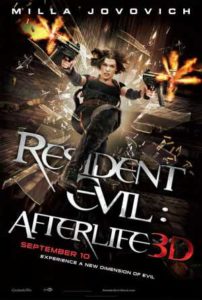Based on the series of Japanese video games (where they are known as Biohazard), the film versions of the Resident Evil franchise have taken on a life of their own. The first of these, released back in 2002 and helmed by Paul W.S. Anderson (Alien vs. Predator), was a unique twist on the zombie genre and gave geeks one more reason to drool over supermodel-turned-actress Milla Jovovich (The Fourth Kind). After handing his scripts to the subsequent sequels to directors Alexander Witt and Russell Mulcahy (Give ‘Em Hell, Malone), Anderson has returned from running a Death Race to once more send Alice into battles with hordes of creatures with targets on their foreheads. Perhaps he should have stuck to the scripts.
Picking up immediately after the events of Resident Evil: Extinction, Alice (Milla Jovovich) and her hordes of genetically-enhanced clones invade the high-tech Japanese digs of the wicked Umbrella Corporation. Although largely destroying the facility, Albert Wesker (Shawn Roberts) manages to inject her with a serum that neutralises the T-virus that courses through her veins. The now super-powerless Alice is left to wander the Earth searching for Arcadia, a ‘town’ that is broadcasting a message indicating they are free of the infection that has now turned much of the world into the undead. Travelling to Alaska to find Arcadia, Alice is reunited with Claire Redfield (Ali Larter), although she is suffering severe memory loss. Hooking up with a group of survivors in Los Angeles, Alice must now find a way to get to Arcadia and avoid the horde of zombies hungry for flesh. Yet not everything is as it seems…
Resident Evil: Afterlife is a shambolic mess. It is definitely a case of style over substance, except even the style feels like it has been chewed over several times by the undead. Using the same 3D Fusion Camera system developed by James Cameron (Avatar), this is one of the prime examples of why 3D should never be seen in a major motion picture ever again. Despite the largest budget of a Resident Evil film to date, many of the effects look cheap and obvious through the 3D goggles affixed to our collective noggins. It is a shame, then, that the film largely relies on these and slick action sequences to prop up the film’s slender plot. Indeed, the film seems content to meander from scene to scene, throwing unnecessary items like cohesion out for the sake of slick set-piece sequences involving guns. Lots of of guns. Indeed, at one point Alice seems to be randomly back in possession of her abilities again, despite being as weak as a kitten shortly after losing them.
Actually, for a zombie film, Resident Evil: Afterlife is surprisingly light on the undead. There are plenty of them to be seen outside the building, and there is a giant hulk of a creature with a potato sack on its head, but the old-fashioned shuffling flesh-biters don’t get much to sink their teeth into. Yet the worst crime of Resident Evil: Afterlife is that it leaves us no further along Alice’s arc than we were at the start of the film. Without spoiling the ending, there is an obvious set-up for the inevitable sequel (that has been confirmed within the last few weeks). This is lazy filmmaking, and only the most die-hard of Resident Evil fans (which I would have considered myself up until this point) will be looking forward to the afterlife of this franchise.
Resident Evil: Afterlife will be released by Sony Pictures Australia on 14 October 2010.






No Responses